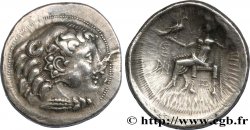E-auction 219-144078 - bga_398353 - DANUBIAN CELTS - IMITATIONS OF THE TETRADRACHMS OF ALEXANDER III AND HIS SUCCESSORS Tétradrachme, imitation du type de Philippe III
You must signin and be an approved bidder to bid, LOGIN TO BID. Accounts are subject to approval and the approval process takes place within 48 hours. Do not wait until the day a sale closes to register. Clicking on « bid » constitutes acceptance of the terms of use of cgb.fr private e-auctions.
Bids must be placed in whole Euro amounts only. The sale will start closing at the time stated on the item description; any bids received at the site after the closing time will not be executed. Transmission times may vary and bids could be rejected if you wait until the last second. For further information ckeck the E-auctions F.A.Q.
NO BUYER'S FEE.
NO BUYER'S FEE.
| Estimate : | 120 € |
| Price : | 69 € |
| Maximum bid : | 75 € |
| End of the sale : | 26 June 2017 14:03:00 |
| bidders : | 9 bidders |
Type : Tétradrachme, imitation du type de Philippe III
Date: c. IIe siècle AC.
Metal : silver
Diameter : 31,5 mm
Weight : 15,68 g.
Rarity : R1
Coments on the condition:
Droit en reliefs mais sans motif associé à un revers encore identifiable. Patine grise
Catalogue references :
Obverse
Obverse legend : ANÉPIGRAPHE.
Obverse description : Restes de la tête imberbe d’Héraklès à droite, coiffé de la léonté.
Reverse
Reverse legend : LÉGENDE ILLISIBLE.
Reverse description : Zeus assis à gauche, tenant un aigle de la main droite et un sceptre long de la main gauche ; monogramme dans le champ à gauche et sous le trône.
Commentary
Ces monnaies dégénèrent jusqu’à ce que le droit ne soit plus du tout identifiable, laissant la place à une masse en relief, sans aucun motif.








 Report a mistake
Report a mistake Print the page
Print the page Share my selection
Share my selection Ask a question
Ask a question Consign / sell
Consign / sell
 Full data
Full data









